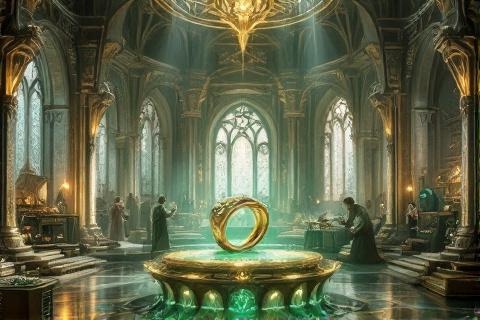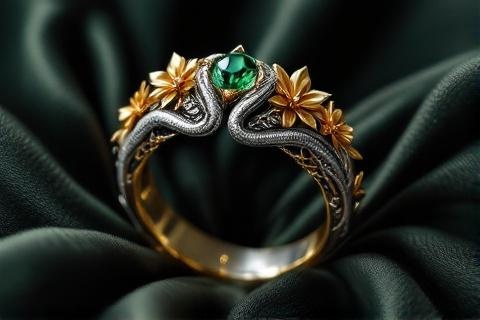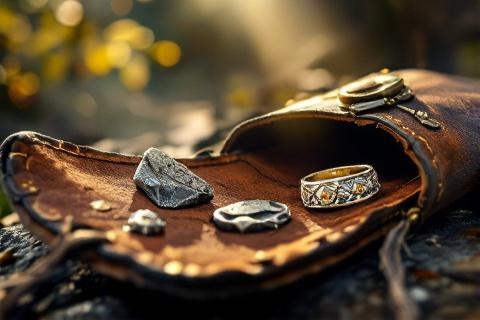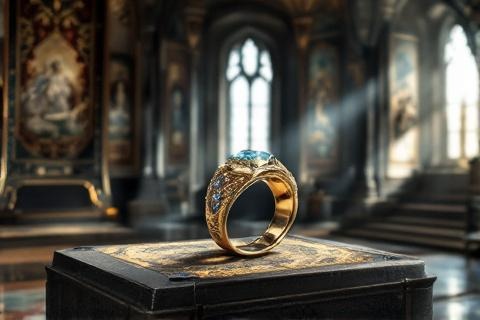
Ring of Barahir: The Heirloom of Elendil
The Legendary Ring That Bound the Lineages of Elves and Men
Origins in the First Age

The Ring of Barahir originated in the blessed realm of Valinor
during the Years of the Trees, crafted by the skilled
hands of the Noldorin Elves before their exodus to
Middle-earth. This ancient ring was forged during an era
of unprecedented craftsmanship and artistic achievement among the
Elves, incorporating techniques and materials that would become
legendary in later ages.
As one of the most recognizable emblems of the House of Finarfin, the ring
represented the nobility and wisdom of this distinguished lineage of the Noldor.
Finarfin, third son of Finwë and ruler of the Noldor who
remained in Valinor, passed this ring to his son
Finrod, who would later become known as Felagund,
the Lord of Caves and King of Nargothrond.
The ring's distinctive design featured two serpents with emerald eyes, their
bodies intertwined beneath a crown of golden flowers. Each serpent consumed the
tail of the other, creating an endless circle that symbolized eternal cycles and
bonds. The craftsmanship displayed in the ring showcased the pinnacle of
Noldorin metalwork, with intricate details wrought in the precious metal that
captured the light in ways that seemed almost magical to mortal eyes.
The Oath of Felagund
During the devastating Battle of Sudden Flame, known
in Sindarin as the Dagor Bragollach, Barahir and his men saved Finrod Felagund's
life in the Fens of Serech. In the midst of this catastrophic battle that broke
the Siege of Angband, Barahir's company fought through waves of
Morgoth's forces to rescue the Elven king, who had become
surrounded and would have certainly perished without their intervention.
In recognition of this valiant deed, Finrod bestowed his ring upon Barahir,
swearing an oath of eternal friendship and aid to Barahir and his descendants.
This oath was not merely a personal pledge but carried the weight of a binding
promise that would echo through the ages of Middle-earth. The words spoken by
Finrod on that day became a testament to the unbreakable bonds between the
highest houses of Elves and Men.
The exchange established a lasting alliance between the House of Finarfin and
the House of Bëor, marking one of the most significant partnerships between the
Eldar and the Edain. This friendship would prove crucial in the
struggles against Morgoth and would influence the course of events throughout
the First Age and beyond.
The ring became more than just a token of gratitude; it transformed into a
powerful symbol of the alliance between the Firstborn and the
Followers. It represented the highest ideals of loyalty, courage,
and friendship between the two kindreds, setting a precedent for future
relationships between Elves and Men that would shape the history of
Middle-earth.
Physical Characteristics and Craftsmanship

The ring's physical construction showcased the masterful silverwork of the
Noldor, with its body fashioned from the purest silver available in Valinor. The
emeralds set as the serpents' eyes were not merely decorative but were specially
chosen gems that captured and reflected light in a way that seemed to hold the
memory of the Two Trees themselves. The intricate details of the metalwork
demonstrated a level of craftsmanship that would become impossible to replicate
in later ages.
The twin serpents motif held deep significance in Noldorin culture, representing
wisdom, continuity, and the eternal nature of true bonds. This symbol was
particularly meaningful to the House of Finarfin, as it reflected their
reputation for wisdom and foresight among the Noldor. The serpents' circular
position, each consuming the other's tail, spoke to the endless cycle of
friendship and obligation that the ring represented.
The crown of golden flowers that surmounted the serpents was crafted to
represent the House of Finarfin in its glory. Each golden flower was
individually wrought with remarkable detail, symbolizing the prosperity and
nobility of Finarfin's line. These flowers were said to be modeled after the
golden blooms that grew in the gardens of Valinor, preserving their memory in
precious metal for all time.
Inheritance Through the Ages
After Barahir's death at the hands of Morgoth's servants in Dorthonion, the ring
passed to his son Beren under tragic circumstances. The ring
was recovered from Barahir's lifeless hand by Beren, who had been away scouting
when his father and companions were slain. This moment marked a pivotal point in
the ring's history, as it became not just a symbol of alliance but also a
reminder of the cost of resistance against the Enemy.
When Beren later sought aid in Nargothrond, the ring served as proof of his
identity to Finrod Felagund. Upon seeing the ring, Finrod immediately recognized
it and honored his oath to Barahir by agreeing to aid Beren in his quest to
recover a Silmaril from Morgoth's crown. This decision
would ultimately lead to Finrod's death, further hallowing the ring's
significance.
Throughout the remainder of the First Age and into the Third
Age, the ring was carefully preserved as a precious heirloom.
It survived the War of Wrath and the drowning of
Beleriand, passing through generations of noble houses and
maintaining its significance as a symbol of the ancient bonds between Elves and
Men.
Legacy in the Third Age

The Ring of Barahir remarkably survived the catastrophic downfall of
Númenor, preserved by Elendil along with other precious
heirlooms when he escaped the destruction. This survival made the ring one of
the few tangible links to the ancient days of alliance between Elves and Men
that remained in Middle-earth.
Following the establishment of the Northern Kingdom, the ring
became a crucial heirloom of the Chieftains of the Dúnedain. It was passed down
through generations of the Heirs of Isildur, serving as a symbol of their
authority and their connection to the ancient nobility of Númenor and the First
Age.
The ring played a vital role in establishing Aragorn's claim to the throne of
Gondor, as it provided physical proof of his descent from
Elendil and the kings of old. Its very existence helped validate his lineage
when the time came for the return of the king.
Throughout the Third Age, the ring served as a vital symbol in maintaining the
line of Elendil among the Dúnedain. Even as their kingdom diminished and their
people became wanderers in the North, the ring remained a constant reminder of
their noble heritage and their ancient alliances.
Symbolic Meaning and Power
The Ring of Barahir stood as a powerful representation of the unique union
between the Eldar and the Edain, embodying the special relationship that existed
between these two kindreds. It served as a reminder of the time when Elves and
Men fought side by side against the darkness and formed bonds of friendship that
would influence all subsequent ages.
As a symbol of nobility, the ring carried the weight of ancient lineages and the
memory of great deeds performed by both Elves and Men. Its very existence spoke
of the highest achievements of both peoples and their capacity for honor,
courage, and loyalty.
The ring's significance in Middle-earth history extended far beyond its material
worth, as it represented one of the few surviving artifacts that connected the
latter ages to the noble days of the First Age. It served as a tangible link to
the ancient times of glory and the great alliances that shaped the destiny of
Middle-earth.
Cultural Impact and Historical Significance

The ring served as a crucial instrument in maintaining the purity and legitimacy
of the bloodline of Númenor through the ages. Its passage from one generation to
the next helped ensure the continuation of the line of kings, even during the
long years of the kingdom in exile.
As a means of identifying the true heirs of Isildur, the ring played a vital
role in preserving the royal succession. Its presence helped prevent false
claims to the throne and ensured that the leadership of the Dúnedain remained
with those who truly carried the blood of Elendil.
For the people of Gondor, the ring represented hope for the eventual restoration
of their kingdom to its former glory. Its survival through the ages served as a
promise that the line of kings would one day return to claim the throne of the
Reunited Kingdom.
The ring's enduring presence symbolized the lasting bonds between Elves and Men,
even as the Elves gradually departed from Middle-earth. It remained as a
testament to the special relationship between the two peoples and the lasting
impact of their alliance on the history of Arda.
